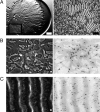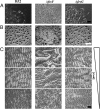Predataxis behavior in Myxococcus xanthus
- PMID: 18952843
- PMCID: PMC2579389
- DOI: 10.1073/pnas.0804387105
Predataxis behavior in Myxococcus xanthus
Abstract
Spatial organization of cells is important for both multicellular development and tactic responses to a changing environment. We find that the social bacterium, Myxococcus xanthus utilizes a chemotaxis (Che)-like pathway to regulate multicellular rippling during predation of other microbial species. Tracking of GFP-labeled cells indicates directed movement of M. xanthus cells during the formation of rippling wave structures. Quantitative analysis of rippling indicates that ripple wavelength is adaptable and dependent on prey cell availability. Methylation of the receptor, FrzCD is required for this adaptation: a frzF methyltransferase mutant is unable to construct ripples, whereas a frzG methylesterase mutant forms numerous, tightly packed ripples. Both the frzF and frzG mutant strains are defective in directing cell movement through prey colonies. These data indicate that the transition to an organized multicellular state during predation in M. xanthus relies on the tactic behavior of individual cells, mediated by a Che-like signal transduction pathway.
Conflict of interest statement
The authors declare no conflict of interest.
Figures






References
-
- King N. The unicellular ancestry of animal development. Dev Cell. 2004;7:313–325. - PubMed
-
- Zusman DR, Scott AE, Yang Z, Kirby JR. Chemosensory pathways, motility and development in Myxococcus xanthus. Nat Rev Microbiol. 2007;5:862–872. - PubMed
-
- Mignot T, Merlie JP, Jr, Zusman DR. Regulated pole-to-pole oscillations of a bacterial gliding motility protein. Science. 2005;310:855–857. - PubMed
Publication types
MeSH terms
Substances
Grants and funding
LinkOut - more resources
Full Text Sources
Other Literature Sources

